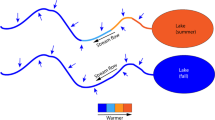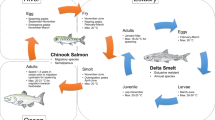Abstract
Native trout species, such as the redband trout (Oncorhynchus mykiss), occupy thermally harsh stream habitats in hot, arid rangeland basins of the western United States. Declines in the distribution and abundance of these species has generated interest in understanding how these cold water species survive in these systems, as well as in identifying opportunities to restore these species to their former ranges. The purpose of this study was to assess the potential for thermal stratification to provide thermal refuge for redband trout in stream pools characterized by warm intermittent flow conditions on arid rangelands. We studied vertical thermal stratification in two pools during three summers on Boles Creek located on the Modoc Plateau in extreme northeastern California. Water and air temperature data were collected on a 0.5 h time step from 15-Jun through 15-Sep during 1996, 1997, and 2000 using commercial temperature data-loggers. Water temperature was measured at the top (0.3 m below pool surface) and bottom (0.3 m above pool substrates) of each pool. Vertical thermal stratification occurred within these pools creating conditions as much as 7.6 ˚C cooler and consistently more constant at the bottom of pools compared to pool surface waters. Thermal stratification was dependent upon air temperature with the magnitude of stratification increasing as air temperature increased. The magnitude of thermal stratification varied significantly from year to year, likely reflecting variation in annual weather conditions. The thermal regime in the study pools was often near the upper lethal limit reported for redband trout, but temperatures at the bottom of these pools did offer refuge from lethal temperatures realized near the pool surface. Temperatures at pool bottom were consistently above optimal levels published for redbands.
Similar content being viewed by others
References
Baltz, D.M., Vondracek, B., Brown, L.R., & Moyle, P. B. (1987). Influence of temperature on microhabitat choice by fishes in a California stream. Transactions of American Fisheries Society, 116, 12–20.
Behnke, R.J. (1992). Native trout of western North America. Monograph 6. Bethesda, MD: Amer. Fisheries Soc.
Bjornn, T. C., & Reiser, D.W. (1991). Habitat requirements of salmonids in streams. In W. R. Meehan (Ed.), Influences of forest and rangeland management on salmonid fishes and their habitats (pp. 83–138). Bethesda, MD: Amer. Fisheries Soc., Special Publication.
Bowers, W., Hosford, B., Oakley, A., & Bond, C. (1979). Wildlife habitats in managed rangelands — the Great Basin of southeastern Oregon. Gen. Tech. Rep., PNW-84, USDA Forest Service.
Constantz, J. (1998). Interaction between stream temperature, streamflow, and groundwater exchanges in alpine streams. Water Resources Research, 34, 1609–1615.
Ebersole, J.L., Liss, W.J., & Frissell, C.A. (2001). Relationship between stream temperature, thermal refugia and rainbow trout Oncorhynchus mykiss abundance in arid-land streams in the northwestern United States. Ecological Freshwater Fish, 10, 1–10.
Ebersole, J.L., Liss, W.J., & Frissell, C.A. (2003). Cold water patches in warm streams: physiochemical characteristics and the influence of shading. Journal of American Water Resources Assocociation, 39, 355–368.
Gamperl, A., Rodnick, K., Faust, H., Venn, E., Bennett, M., Crawshaw, L., Keeley, E., Powell, M., & Li, H. W. (2002). Metabolism, swimming performance, and tissue biochemistry of high desert redband trout (Oncorhynchus mykiss ssp.): evidence of phenotypic differences in physiological function. Physiological Biochemical and Zoology, 75, 413–431.
Hawkins, C.P., Hogue, J.N., Decker, L.M., & Feminella, J.W. (1997). Channel morphology, water temperature, and assemblage structure of stream insects. Journal of North American Benthological Society, 16, 728–749.
Hokanson, K.E.F, Kleiner, C.F., & Thorslund, T.W. (1977). Effects of constant temperatures and diel temperature fluctuations on specific growth and mortality rates and yield of juvenile rainbow trout (Salmo gairdneri). Journal of Fisheries Research Board of Canada, 34, 639–648.
Hunnington, C., Nehlsen, W., & Bowers, J. (1996). A survey of healthy native stocks of anadromous salmonids in the Pacific northwest and California. Fisheries, 21, 6–14.
Issak, D.J., & Hubert, W.A. (2001). A hypothesis about factors that affect maximum summer stream temperatures across montane landscapes. Journal of American Water Resources Association, 37, 351–366.
Isaak, D.J., & Hubert, W.A. (2004). Nonlinear response of trout abundance to summer stream temperatures across a thermally diverse montane landscape. Transactions of American Fisheries Society, 133, 1254–1259.
Jacobsen, D., Schultz, R., & Encalada, A. (1997). Structure and diversity of stream invertebrate assemblages: the influence of temperature with altitude and latitude. Freshwater Biology, 38, 247–261.
Jobling, M. (1981). Temperature tolerance and the final preferendum-rapid methods for the assessment of optimum growth temperatures. Journal of Fish Biology, 19, 439–455.
Larson, L.L., & Larson, P.A. (2001). Influence of thermal gradients on the rates of heating and cooling of streams. Journal of Soil and Water Conservation, 56, 38–43.
Li, H.W., Lamberti, G.A., Pearsons, C.N., Tait, C.K., Li, J.L., & Buckhouse, J.C. (1994). Cumulative effects of riparian disturbances along high desert trout streams of the John Day basin, Oregon. Transactions of American Fisheries Society, 123, 627–640.
Lyons, J. (1996). Patterns in the species composition of fish assemblages among Wisconsin streams. Environmental Biology of Fishes, 45, 329–341.
Matthews, K.R., Berg, N.H., Azuma, D.L., & Lambert, T.R. (1994). Cool water formation and trout habitat use in a deep pool in the Sierra Nevada, California. Transactions of American Fisheries Society, 123, 549–564.
Matthews, K.R., & Berg, N.H. (1997). Rainbow trout responses to water temperature and dissolved oxygen stress in two southern California stream pools. Journal of Fish Biology, 50, 50–67.
Mohseni, O., & Stefan, H.G. (1999). Stream temperature air temperature relationship: a physical interpretation. Journal of Hydrology, 218, 128–141.
Moyle, P.B. (2002). Inland fishes of California. Berkeley and Los Angeles, California: University of California Press.
Muhlfeld, C.C., Bennett, D.H., & Marotz, B. (2001). Summer habitat use by Columbia River redband trout in the Kootenai River drainage, Montana. North American Journal of Fisheries Management, 21, 223–235.
Nehlsen, W., Williams, J.E., & Lichatowich, J.A. (1991). Pacific salmon at the crossroads — stocks at risk from California, Oregon, Idaho, and Washington. Fisheries, 16, 4–21.
Nielsen, J.L., Lisle, T.E., & Ozaki, V. (1994). Thermally stratified pools and their use by steelhead in northern California streams. Transactions of American Fisheries Society, 123, 613–626.
Pinheiro, J.C., & Bates, D.M. (2000). Mixed Effects model in S and S-Plus. New York, New York: Springer.
Poole, G.C., & Berman, C.H. (2001). An ecological perspective on in-stream temperature: natural heat dynamics and mechanisms of human-caused thermal degradation. Environmental Management, 27, 787–802.
Rodnick, K.J., Gamperl, A.K., Lizars, K.R., Bennett, M.T., Rausch, R.N., & Keeley, E.R. (2004). Thermal tolerance and metabolic physiology among redband trout populations in southeastern Oregon. Journal of Fish Biology, 64, 310–335.
Stefan, H.G., & Preudhomme, E.B. (1993). Stream temperature estimation from air temperature. Water Resources Bulletin, 29, 27–45.
Tate, K.W., Lile, D.F., Lancaster, D.L., Porath, M.L., Morrison, J.A., & Sado, Y. (2005). Statistical analysis of monitoring data to evaluate stream temperature — a watershed scale case study. California Agriculture, 59, 161–167.
Thurow, R.F., Lee, D.C., & Rieman, B.E. (1997). Distribution and status of seven native salmonids in the interior Columbia River basin and portions of the Klamath River and Great Basins. North American Journal of Fisheries Management, 17, 1094–1110.
Torgersen, C.E., Price, D.M., Li, H.W., & McIntosh, B.A. (1999). Multiscale thermal refugia and stream habitat associations of chinook salmon in northeastern Oregon. Ecological Applications, 9, 301–319.
United States Department of Agriculture Soil Conservation Service (1980). Soil survey of modoc county, California, Alturas area. Washington, D.C.
Vinson, M., & Levesque, S. (1994). Redband trout response to hypoxia in a natural environment. Great Basin Naturalist, 54, 150–155.
Webb, B.W., Clark, P.D., & Walling, D.E. (2003). Water—air temperature relationships in a Devon River system and the role of flow. Hydrological Processes, 17, 3069–3084.
Zoellick, B.W. (1999). Stream temperatures and the elevational distribution of redband trout in southwestern Idaho. Great Basin Naturalist, 59, 136–143.
Zoellick, B.W. (2004). Density and biomass of redband trout relative to stream shading and temperature in southwestern Idaho. Western North American Naturalist, 64, 18–26.
Author information
Authors and Affiliations
Corresponding author
Rights and permissions
About this article
Cite this article
tate, k.W., lancaster, d.L. & lile, d.F. Assessment of thermal stratification within stream pools as a mechanism to provide refugia for native trout in hot, arid rangelands. Environ Monit Assess 124, 289–300 (2007). https://doi.org/10.1007/s10661-006-9226-5
Received:
Accepted:
Published:
Issue Date:
DOI: https://doi.org/10.1007/s10661-006-9226-5




